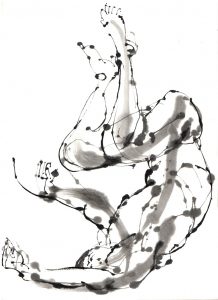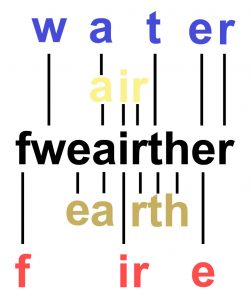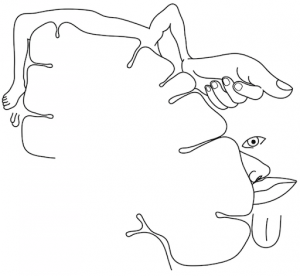Gestalt & Parts Body (Upd: Jul 25, ’22)
“Shed the skin of the body that has been tamed and domesticated.” – Tatsumi Hijikata
The modern human has many mummified areas of the body not in use. We must open the entire body, and this includes the hidden joints such as the sternoclavicular, intercarpal, intertarsal, and costal joints. We must also be aware of the cavities such as the abdomen and mouth. We must wake up! As Artaud once wrote, “The theater of cruelty wants to make the eyelids dance in pairs with the elbows, the kneecaps, the thighbones and the toes, and wants to be seen.”¹
Several of the following exercises in this section are good examples of multiplicity exercises. Generally, in butoh, instead of there being one dancer, there are an endless amount of dancers within (or meta-dancers). Deleuze and Guattari say of this multiplicity: “Each element ceaselessly varies and alters its distance in relation to the others. On the Wolf-Man’s nose, the elements, determined as pores in the skin, little scars in the pores, little ruts in the scar tissue, ceaselessly dance, grow, and diminish. These variable distances are not extensive quantities divisible by each other; rather, each is indivisible, or ‘relatively indivisible.'”²

Whether the elements are pores, cells, or micro facial expressions, the idea is to see them all as distinct dancers. In other words, we are seeing all the intriguing trees in the forest instead of “just a forest.” We are seeing both the parts and the gestalt (whole). In Tatsumi Hijikata’s butoh score Quiet House, he called this concept the nest (nest body, nest eyes, etc.).6
Contemporary Metaphor Theory
In terms of contemporary metaphor theory, the concept of whole can be linked back to the PART-WHOLE image schema as well as the MULTIPLEX/MASS image schema.8 Image schemas to Lakoff and Johnson are “recurrent patterns in perceptual-motor experience that derive from our bodily interaction with the physical world.”9
According to SIL International Glossary of Linguistic terms, a part-whole schema entails “physical or metaphorical wholes along with their parts and a configuration of the parts.”8 In this case we are contrasting body parts with the whole body. Whereas a multiplex/mass image schema is a “continuous mass or […] a one-dimensional entity, e.g. seeing the peas as one entity.”10 Likewise, we see the body as one entity when we mention the term “whole body.”
Like so many other image schemas, we are bombarded with this schema at all moments of our lives.
The FRONT-BACK image schema really reflects the human,10 and so it is anthropocentric. Trees, for instance, do not have a front and back. In butoh, we can deterritorialize what it means to be back or front.
John Vervaeke’s Feature & Gestalt
In Episode 9 of Vervaeke’s lecture series called Awakening From the Meaning Crisis, Vervaeke mentions feature and gestalt which can be thought of in terms of the body as awareness of an element of a body versus the whole body.11
He draws upon an exercise of hitting a cup with a pen: “You can be aware of the cup through the pen. So the probe is transparent to you, and the cup is opaque. Or you can be aware of the pen through your fingers. Or you can be aware of your fingers through your feelings.” He follows this by stating that one can be aware through one’s glasses (transparency) or we can be aware of one’s glasses (opaqueness).
He gives the following regarding scaling up and scaling down.
Attention is flowing up and down between feature and gestalt.
Mindfulness optimizes the attention processes.
Scaling up is moving from feature to gestalt and moving from opacity to transparency.
Scaling down is moving from gestalt to feature and from transparency to opacity.
Meditation means moving towards the center.
The closer one gets to transparency (scaling up), the more connected to the world as a whole one can get which at the extreme end Vervaeke calls resonant at-onement.
At the other end, the closer one gets to opacity (scaling down), the more disconnected one is from things which at the extreme end Vervaeke calls pure consciousness event where one is only present of consciousness itself.
When these two states combine, it is a non-dual state. We can roughly translate feature and gestalt as inside and outside. Rhizome Lee always mentioned being 50% inside and 50% outside (what Vervaeke terms meditation), and I condone being able to shift freely from the two, as does Vervaeke.
Partial List of Locomotor & Nonlocomotor Movements/Gestalts
This list (without the parenthesis) comes from Helen Landalf and Pamela Gerke, and is used to teach children how to move. Go through the entire list and especially mix and match them!4 In parenthesis are example qualia/qualia-worlds associated with the following.
The reason this manual has called these gestalts is because when these actions are being undertaken, one is not necessarily thinking of a specific body part but of an entire type of system (gestalt).
Locomotor
crawl (bug), gallop (horse gallop), hop (bunny hop), jump (suddenly frightened cat jump), leap (leaping over a puddle), roll (snow ball rolling down mountain), run (running from a wasp), scoot (you have an itchy butt and the floor helps you scratch it), slide (ice skating), slither (an eel in a swamp), tiptoe (tiptoe into the sleeping dragon’s chamber to steal his cookies), walk (old man walk). LOCOMOTION is also an image schema in contemporary metaphor theory.7
Nonlocomotor (stationary)
bend, carve, dab, flick, float, glide, poke, press, punch, shake, slash, spin, squirm, stretch, swing, turn, twist, wiggle, wring
Traveling Motif For Feature/Parts
The traveling motif is a good exercise in remapping or rebounding movement or felt qualias. One participant is to create one form of movement, whether it be with the whole body or a segment of it (like with the head or arm). Then someone calls out a different body part in which the same movement or felt qualia is imitated. For instance, if one participant decided to engage in figure 8s with the hips, and somebody called out eyebrows, then the participant is to shift the hip figure 8s to the eyebrows.
The most important thing is to never die or give up. Movement will always continue. Even if the eyes are the only things left working, then the eyes will become the dancer. This exercise will condition one into noting that there are multiple paths to one such subject or theme. If we think of the body as a multiplicity of dancers, we will not have just one dancer, but 10,000 dancers.
Essentially, this exercise converts the body into a rhizome, of which Deleuze and Guattari state, “may be broken, shattered at a given spot, but it will start up again on one of its old lines, or on new lines. You can never get rid of ants because they form an animal rhizome that can rebound time and again after most of it has been destroyed.”4
Hijikata’s Bugs Crawl
The following is a very popular butoh score (butoh-fu) of Tatsumi Hijikata. Similar to Body Fish Tank, it utilizes the small animal kingdom to open/catharsize the entire body. Curiously, some of us may have been exposed in our childhood to the saying of ants in your pants making you do the boogie dance.
The bugs exercise can also be used as a means to empty the body, the first step of butoh creation. Read Bugs Crawl here.5
Elements Gestalts
We can never get enough of the elements qualia into our body. There’s a reason why they are even important in works of magick. The elements can also be other ways in which to embody different forms of density. The density increases, for instance, from air, water, to earth.
Water
Feel the water body. Water takes on many forms. Feel the soft but also the turbulent, e.g. gentle waves or a whirlpool. Perhaps even make the sound of the varying forms of water. You may also feel the body as a hollow human-shaped plastic bag with open ends. Feel water entering through in varying ways, soft or turbulent. Find deep nurture. Physically touch water. Water element is the main focus of the body practice Noguchi Taiso.
Air
Feel lightness like a feather or a leaf. Wind, like water, can take on both gentle and turbulent forms. Make breath sounds. Find gentle spring air or tornadoes. Find aloofness or space to finally breathe. Physically feel the air.
Fire
Feel the varying fire qualias such as camp fire or burning passion. Flames can have a knife-like dance. Perhaps make cracking sounds. Feel excessively elevated or overtaken by a calm warmth. If there is fire nearby, feel the warmth.
Earth
Resonate with the ground itself. Other forms of bodywork may utilize props (yoga mats, cushions) but I recommend not using any props in order to build a deeper relationship with the floor or ground itself. A rock or dirt in the hands may help resonate with earth. The sound of an earthquake may assist in resonation. Stomping or pounding the ground may assist in developing this qualia for earth much like it is often done in African dance.
Feeling the qualia of something related to earth (mountain, rock) is another way to resonate.
The Four Elements Combined (Fweairther)
We can dance with all the elements simultaneously. The fweairther contains them all. Enter into the qualia of the magician.
Element Gradient/Synthesizer Button
One does not need to get stuck on one element, but can explore the in-between zones. Try shifting smoothly between the elements.
 Exercise 1: 4 Element Shift
Exercise 1: 4 Element Shift
Resonate with changing the four elements in your body by will.
Exercise 2: 4 Element Chimera
In chimera fashion, make earth your head, ir your right arm, water your left arm, and fire your feet. You can also do this while on your back.
Exercises
1. Endless Dots (Parts/Gestalt)
Feel thousands of dots all throughout the body. Each of these dots is a star or universe. Each is a unique dancer. See Chantaal Stewart’s artwork (but add even more dots!).
2. Break! (Parts/Gestalt)
Gradually, the entire body breaks to tiny bits. Dance the new motions that result.
3. Segmentation Gradient/Synthesizer Knob (Parts/Gestalt)
We can choose to put the degree of this breaking (becoming-multiplicity) into a gradient system, where one end is one unit (one dancer, 0% segmentation) and the other, endless units (100% segmentation).

Play along the gradient of segmentation, e.g. 37% → 20%, 70% → 90%.
4. Non-Mover Investigator (Parts)
Try very hard to find areas that you have been hiding from yourself. If you find them and you still cannot move them, move around them and over time, you will get closer and closer to the target. This exercise can be taken further by having someone possess the movement wand which will be a flower or weed which they can touch to any part of the body that they feel is being ignored. Whichever part of the body is touched is to be danced.
5. Fine Motor Tuning (Parts/Gestalt)

Butoh utilizes the entire body. Naturally, there are specific parts of our body that have more fine motor abilities than others. We should try however to open the whole body into having fine motor capabilities.
Writing With Other Parts of Your Body
Take a pen or marker and try to hold it with different parts of your body, e.g. in the belly button, between the elbows, between the neck. Try to write something legible. If this skill is practiced enough, there will be sensory input and fine motor function in that certain space. For many of these placements of the pen, the entire body will have to assist.
One can shift freely from parts or gestalt awareness. If one is very focused on the specific part of the body drawing, then it is parts, but if one opens the awareness to the whole-body compensation that has to happen, then this gestalt awareness.
Marble Maze
Place a marble or small ball on your abdomen or any part of the body while you are laying in some fashion the floor. By manipulating your muscles, try manipulating the marble. Turn your body into a marble maze.
6. Odd Disco Dancer (Gestalt)
Some naturally move a lot of their body at the disco. We can use this and take it further. Try disco dancing while in strange or difficult positions such as on all fours or bridge, handstand against the wall, or while hugging a tree with all four limbs. Make use of upbeat music.
7. Marble Body (Parts/Gestalt)
Your body is composed of only marbles inside. What happens? How does this make you move?
8. Vine Body (Parts/Gestalt)
The body becomes nothing but vines that travel the space. Vines take over the arms and fingers, and grow out of different parts of the body. There is also a lust to take over a wall or surface.
10. Body Fish Tank (Parts/Gestalt)
This exercise was shown by Denise Fujiwara at the 2000 Seattle Butoh Festival. The dancer’s body is full of water. A single fish swims to every location. Then more fish appear till there a hundred. Then the process reverses until all the fish disappear. Originally, the movements are meant to be minimal, but also try larger movement if this resonates.
11. Dance! Dance! (Gestalt)
Someone is shooting at your feet! One is not thinking of feet or parts. One has no time for that. It is only whole body acting.
12. Mad Lib One-liner (Parts/Gestalt)
My entire body is full of _noun_.
13. Body Shell (Parts/Gestalt)
The entire body is incased in a shell that only has 1 cm of space. Which means that there is only that space with the head, between fingers, pelvis, arms, etc. Something moves you (such as a disco or an image) and you are made to dance within that space given.